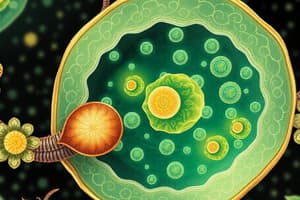Podcast
Questions and Answers
Which of the following is a structure found in chloroplasts?
Which of the following is a structure found in chloroplasts?
- Nucleolus
- Rough endoplasmic reticulum
- Thylakoid (correct)
- Golgi body
What is the primary function of the Golgi apparatus?
What is the primary function of the Golgi apparatus?
- Storage of hereditary material
- Photosynthesis
- Protein synthesis
- Modification and packaging of proteins and lipids (correct)
Which organelle is responsible for protein synthesis in eukaryotic cells?
Which organelle is responsible for protein synthesis in eukaryotic cells?
- Nucleus
- Smooth endoplasmic reticulum
- Rough endoplasmic reticulum (correct)
- Mitochondrion
What is the primary function of the nucleus in eukaryotic cells?
What is the primary function of the nucleus in eukaryotic cells?
Which organelle is involved in the light-dependent reactions of photosynthesis in plants?
Which organelle is involved in the light-dependent reactions of photosynthesis in plants?
Which organelle is responsible for modifying and transporting proteins within eukaryotic cells?
Which organelle is responsible for modifying and transporting proteins within eukaryotic cells?
What is the primary function of thylakoids in chloroplasts?
What is the primary function of thylakoids in chloroplasts?
Which of the following statements about the endoplasmic reticulum (ER) is correct?
Which of the following statements about the endoplasmic reticulum (ER) is correct?
Where are the enzymes involved in the reduction of carbon dioxide to organic material located in chloroplasts?
Where are the enzymes involved in the reduction of carbon dioxide to organic material located in chloroplasts?
Which of the following is a function of the Golgi bodies?
Which of the following is a function of the Golgi bodies?
What is the role of the outer chloroplast membrane?
What is the role of the outer chloroplast membrane?
Which of the following is true about the nucleus in eukaryotic cells?
Which of the following is true about the nucleus in eukaryotic cells?
Which organelle is responsible for the synthesis and packaging of proteins in eukaryotic cells?
Which organelle is responsible for the synthesis and packaging of proteins in eukaryotic cells?
Which organelle is involved in the modification and sorting of proteins and lipids in eukaryotic cells?
Which organelle is involved in the modification and sorting of proteins and lipids in eukaryotic cells?
Which organelle is responsible for the photosynthetic process in plant cells?
Which organelle is responsible for the photosynthetic process in plant cells?
Which organelle contains the genetic material and serves as the control center of eukaryotic cells?
Which organelle contains the genetic material and serves as the control center of eukaryotic cells?
Which organelle in plant cells contains thylakoid membranes, where the light-dependent reactions of photosynthesis occur?
Which organelle in plant cells contains thylakoid membranes, where the light-dependent reactions of photosynthesis occur?
Which organelle is absent in prokaryotic cells but present in eukaryotic cells?
Which organelle is absent in prokaryotic cells but present in eukaryotic cells?
Flashcards are hidden until you start studying
Study Notes
Cell Division and Cytoskeleton
- Haploid sex cells are produced from diploid cells by meiosis
- Cytoskeleton is a network of microfilaments and microtubules in eukaryotic cells
- Cytoskeleton maintains cell shape, positions cell organelles, and enables cell motility
Cell Characteristics: Prokaryotes vs. Eukaryotes
- Prokaryotes: Bacteria, Cyanobacteria, Archaea
- Eukaryotes: Algae, Fungi, Protozoa, Plants, and Animals
- Cell size:
- Prokaryotes: 1-2 µm x 1-4 µm or less
- Eukaryotes: Greater than 5 µm
- Cell wall composition:
- Prokaryotes: Peptidoglycan
- Eukaryotes: Cellulose in algae and plants, chitin in fungi, absent in protozoa and animals
- Osmotic control:
- Prokaryotes: Wall provides mechanical strength to counterbalance turgor pressure
- Eukaryotes: Plasma membrane and contractile vacuole maintain osmotic balance
Plasma Membrane and Organelles
- Plasma membrane:
- Prokaryotes: No sterols, except in Mycoplasma
- Eukaryotes: Sterols present
- Mesosomes:
- Prokaryotes: Present, formed by plasma membrane folding
- Eukaryotes: Absent, but analogous structures present in animal cells (microvilli)
- Mitochondria:
- Synthesize ATP within the mitochondrial lumen
- Enzymes involved in ATP production are located within the inner membrane
- Cristae project into the mitochondrial lumen
- Chloroplasts:
- Present in photosynthetic eukaryotic organisms
- Structures reveal thylakoids, thylakoid membrane, and stroma
Ribosomes, Endoplasmic Reticulum, and Golgi Bodies
- Ribosomes:
- Prokaryotes: 70S, freely distributed in cytoplasm
- Eukaryotes: 80S, bound to ER
- Endoplasmic Reticulum (ER):
- Absent in prokaryotes
- Present in eukaryotes, providing surface area for protein and lipid synthesis, transporting molecules, and storing synthesized molecules
- Golgi bodies:
- Absent in prokaryotes
- Present in eukaryotes, involved in protein modification and transport
Additional Cell Components
- Lysosomes:
- Absent in prokaryotes
- Present in eukaryotes, involved in cellular digestion
- Peroxisomes:
- Absent in prokaryotes
- Present in eukaryotes, involved in cellular metabolism
- Centrioles:
- Absent in prokaryotes
- Present in eukaryotes, involved in cell division and cilia formation
- Nucleolus:
- Absent in prokaryotes
- Present in eukaryotes, involved in ribosome synthesis
- Vacuoles:
- Absent in prokaryotes
- Present in eukaryotes, involved in cellular storage and recycling
- Flagella and Cilia:
- Present in some prokaryotes and eukaryotes, involved in cell motility
Studying That Suits You
Use AI to generate personalized quizzes and flashcards to suit your learning preferences.




